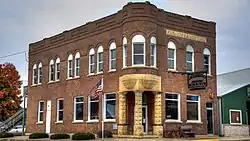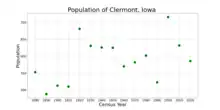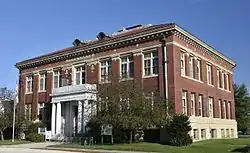Clermont, Iowa | |
|---|---|
 | |
| Nickname: Brick City | |
 Location of Clermont, Iowa | |
| Coordinates: 42°59′58″N 91°39′17″W / 42.99944°N 91.65472°W | |
| Country | |
| State | |
| County | Fayette |
| Area | |
| • Total | 1.27 sq mi (3.30 km2) |
| • Land | 1.26 sq mi (3.26 km2) |
| • Water | 0.01 sq mi (0.03 km2) |
| Elevation | 860 ft (262 m) |
| Population (2020) | |
| • Total | 586 |
| • Density | 465.08/sq mi (179.54/km2) |
| Time zone | UTC-6 (Central (CST)) |
| • Summer (DST) | UTC-5 (CDT) |
| ZIP code | 52135 |
| Area code | 563 |
| FIPS code | 19-14250 |
| GNIS feature ID | 0455473 |
| Website | www |
Clermont[lower-alpha 1] is a city in Fayette County, Iowa, United States. The population was 586 at the 2020 census.[3] Clermont is home to Montauk, the mansion of former Iowa governor William Larrabee, along with much historic architecture. Scenes for the movie The Straight Story were filmed here.
Geography
Clermont is located at 42°59′58″N 91°39′17″W / 42.99944°N 91.65472°W (42.999339, -91.654699)[4] on the Turkey River.
According to the United States Census Bureau, the city has a total area of 1.23 square miles (3.19 km2), all land.[5]
Demographics
| Year | Pop. | ±% |
|---|---|---|
| 1880 | 553 | — |
| 1890 | 488 | −11.8% |
| 1900 | 513 | +5.1% |
| 1910 | 510 | −0.6% |
| 1920 | 681 | +33.5% |
| 1930 | 631 | −7.3% |
| 1940 | 626 | −0.8% |
| 1950 | 625 | −0.2% |
| 1960 | 570 | −8.8% |
| 1970 | 582 | +2.1% |
| 1980 | 602 | +3.4% |
| 1990 | 523 | −13.1% |
| 2000 | 716 | +36.9% |
| 2010 | 632 | −11.7% |
| 2020 | 586 | −7.3% |
| Source:"U.S. Census website". United States Census Bureau. Retrieved March 29, 2020. and Iowa Data Center Source: | ||

2010 census
As of the census[7] of 2010, there were 632 people, 276 households, and 184 families living in the city. The population density was 513.8 inhabitants per square mile (198.4/km2). There were 310 housing units at an average density of 252.0 per square mile (97.3/km2). The racial makeup of the city was 98.3% White, 1.1% Asian, 0.3% from other races, and 0.3% from two or more races. Hispanic or Latino of any race were 1.4% of the population.
There were 276 households, of which 25.7% had children under the age of 18 living with them, 56.5% were married couples living together, 8.0% had a female householder with no husband present, 2.2% had a male householder with no wife present, and 33.3% were non-families. 27.5% of all households were made up of individuals, and 12% had someone living alone who was 65 years of age or older. The average household size was 2.29 and the average family size was 2.76.
The median age in the city was 45.8 years. 22% of residents were under the age of 18; 7.5% were between the ages of 18 and 24; 19.1% were from 25 to 44; 29.9% were from 45 to 64; and 21.5% were 65 years of age or older. The gender makeup of the city was 47.5% male and 52.5% female.
2000 census
As of the census[8] of 2000, there were 716 people, 293 households, and 193 families living in the city. The population density was 653.9 inhabitants per square mile (252.5/km2). There were 333 housing units at an average density of 304.1 per square mile (117.4/km2). The racial makeup of the city was 97.35% White, 0.42% from other races, and 2.23% from two or more races. Hispanic or Latino of any race were 3.35% of the population.
There were 293 households, out of which 28.3% had children under the age of 18 living with them, 55.3% were married couples living together, 8.2% had a female householder with no husband present, and 33.8% were non-families. 28.7% of all households were made up of individuals, and 16.0% had someone living alone who was 65 years of age or older. The average household size was 2.44 and the average family size was 2.95.
In the city, the population was spread out, with 25.6% under the age of 18, 8.0% from 18 to 24, 24.6% from 25 to 44, 24.0% from 45 to 64, and 17.9% who were 65 years of age or older. The median age was 39 years. For every 100 females, there were 96.2 males. For every 100 females age 18 and over, there were 98.9 males.
The median income for a household in the city was $34,712, and the median income for a family was $39,792. Males had a median income of $27,250 versus $18,563 for females. The per capita income for the city was $14,276. About 4.8% of families and 8.1% of the population were below the poverty line, including 11.9% of those under age 18 and 9.6% of those age 65 or over.
Education


It is a part of the North Fayette Valley Community School District. It was previously a part of the Valley Community School District,[9] which merged into the North Fayette Valley district on July 1, 2018.[10]
Clermont previously had a school building, the former Clermont Public School, built circa 1913, which closed in 1990. Now named the Larrabee Building, it houses administrative offices of the city government and a library. Jason Clayworth and Charles Litchfield of the Des Moines Register described it as "richly decorated in marble".[11]
Notable people
- Anna Matilda Larrabee (1842-1931), social leader; wife of William Larrabee; First Lady of Iowa
- George Botsford, American ragtime composer
- David B. Henderson, former Speaker of the United States House of Representatives
- William Larrabee, former governor of Iowa
- Don Strauch, Arizona mayor and state legislator
See also
Properties listed on the National Register of Historic Places:
Notes
References
- ↑ "2020 U.S. Gazetteer Files". United States Census Bureau. Retrieved March 16, 2022.
- ↑ Sherman, Barney (September 14, 2017). "Iowa Place Names: A-E". Iowa Public Radio. Retrieved June 9, 2021.
- 1 2 "2020 Census State Redistricting Data". census.gov. United states Census Bureau. Retrieved August 12, 2021.
- ↑ "US Gazetteer files: 2010, 2000, and 1990". United States Census Bureau. February 12, 2011. Retrieved April 23, 2011.
- ↑ "US Gazetteer files 2010". United States Census Bureau. Archived from the original on July 2, 2012. Retrieved May 11, 2012.
- ↑ "Census of Population and Housing". Census.gov. Retrieved June 4, 2015.
- ↑ "U.S. Census website". United States Census Bureau. Retrieved May 11, 2012.
- ↑ "U.S. Census website". United States Census Bureau. Retrieved January 31, 2008.
- ↑ "Valley Archived 2018-04-27 at the Wayback Machine." Iowa Department of Education. Retrieved on July 29, 2018.
- ↑ "REORGANIZATION & DISSOLUTION ACTIONS SINCE 1965-66 Archived 2019-02-09 at the Wayback Machine." Iowa Department of Education. Retrieved on July 29, 2018.
- ↑ Clayworth, Jason; Litchfield, Charles (March 21, 2015). "Make or break: Vacant schools test Iowa". Des Moines Register. Retrieved September 15, 2018.